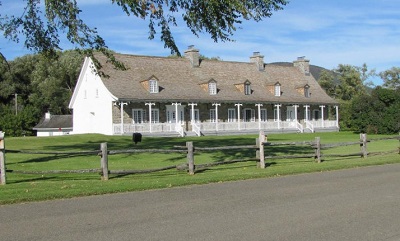Petite-Ferme du cap Tourmente National Historic Site of Canada
Saint-Joachim, Quebec

Principal façade of the house
© Parks Canada | Parcs Canada
Address :
570 du Cap Tourmente Road, Saint-Joachim, Quebec
Recognition Statute:
Historic Sites and Monuments Act (R.S.C., 1985, c. H-4)
Designation Date:
2018-02-27
Dates:
-
1664 to 1667
(Construction)
-
1628 to 1628
(Significant)
-
1664 to 1969
(Significant)
Other Name(s):
-
Petite-Ferme du cap Tourmente
(Designation Name)
-
La Petite-Ferme de la Réserve nationale de faune du Cap-Tourmente
(Other Name)
Research Report Number:
2016-12
DFRP Number:
67466
Description of Historic Place
La Petite-Ferme du cap Tourmente National Historic Site of Canada is located on the shores of the St. Lawrence River, where the river meets the great coastal marsh and tidal plain, in the municipality of Saint-Joachim, 50 km downstream from Québec City. Official recognition refers to a part of the Cap Tourmente National Wildlife Area (CTNWA) in Quebec, in a defined area of approximately 240,500 square metres and which includes a group of farm buildings: a house, a washhouse/blacksmith’s shop, a barn/cowshed, a grain shed, a workshop/bathroom, confirmed and as yet unidentified remnants of the Petite-Ferme as well as natural elements of the site.
Heritage Value
La Petite-Ferme du cap Tourmente was designated a National Historic Site of Canada in 2018. It is recognized because:
located in a landscape of remarkable beauty, where the St. Lawrence River meets the great coastal marsh and tidal plain, it was because of these unique conditions, that early on the site was recognized as being particularly favourable for human settlement; with an Indigenous presence dating back more than 2,000 years, the site is part of a substantial body of known paleohistoric archaeological sites of the Cap Tourmente plains; it is in this strategic location that Samuel de Champlain had a farm built in 1626 for livestock farming before it became a source of food for the small community of the newly formed Québec City. The remnants found on the site or still buried there are among the rare tangible vestiges of Champlain’s work in Canada (or in the Laurentian Valley); purchased by Monsignor François de Montmorency Laval in 1664, it bears witness to the unique evolution of the Séminaire de Québec, which ran the farm for 300 consecutive years and which contributed to its conservation through its continuous presence; united by their history, functions, architecture, and their relationship with the surrounding landscape, the group of farm buildings are reflective of close to 400 years of agricultural use, making this a highly symbolic place.
The site of La Petite-Ferme du cap Tourmente shows evidence of a series of occupations by Indigenous groups followed by other groups of European origin. Archaeological digs have revealed at least two separate periods of occupation by groups of St. Lawrence Iroquoians, a semi-sedentary people who practised agriculture and horticulture, as well as remnants of the Champlain Farm, one of the rare pieces of evidence of Champlain’s work in Canada. The Petite-Ferme building itself was built when work in the area began by the Séminaire de Québec, which operated the farm for 300 years, after it was purchased by Monseigneur François de Montmorency Laval in 1664. The farm contributed to the Séminaire de Québec’s educational work, and, through revenues arising from its operations, to the maintenance of the work of the Séminaire. The house is the only preserved building dating from the French Regime in Cap Tourmente, and is also the oldest evidence of the presence of the Séminaire de Québec. It is a handsome example of a French Regime residence, with picturesque features added in the 19th century showing neo-classical influence.
Source: Historic Sites and Monuments Board of Canada, Minutes, November-December 2016.
Character-Defining Elements
Key elements contributing to the heritage value of this site include:
• Its location on the shoreline of the St. Lawrence River and the integrity of the surrounding natural environment;
• The configuration of the five main buildings oriented toward the shoreline of the St. Lawrence River;
• The simple, plain house built of stone, including evenly-spaced openings for doors and windows on its main facade, its facades covered with white plaster, its steep gable roof with five dormers and three chimney stacks that extends to form an overhang that covers the front veranda;
• The washhouse/blacksmith’s shop made from wood with a gable roof, its long sides with two double-leaf paned windows, and the triple door of the main facade;
• The wooden barn/cowshed with its tin mansard roof, its paned guillotine windows and its two garage doors and two entrance doors with awnings;
• The grain shed with its metal gable roof, its wall with five double doors large enough for cars, and its lean-to in the back;
• The wooden workshop/bathroom with a low-pitch tin roof and its facades with fixed paned windows and its doors with a pediment;
• The consistent esthetic design of the secondary buildings, with their white walls and green trim;
• The agricultural character of the site that facilitates understanding of the history, function and typology of the farm buildings;
• Traces of paleo-historic occupations, including remnants and artifacts;
• The remnants of the farm that Champlain had built in 1626;
• All other as-yet unidentified archaeological remains that could be uncovered within the site.